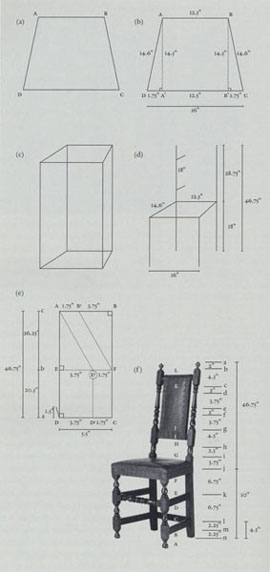
| Figure 45 Composite diagram of the New York side chair illustrated in €g. 3. (Drawing, Neil D. Kamil; art work, Wynne Patterson.) (a) Trapezoid representing the ground plan of the central axes of the four posts considered from an axiometric perspective. (b) Dimensions of the trapezoid providing basic units of measurement. (c) Trapezoid extended vertically to form framework in three dimensions. (d) Chair’s overall dimensions indicating a one-to-one symmetrical relationship between the seat height and the height of the leather back panel (compare to figure 10). (e) Backward rake of the rear posts viewed from the side. (f) Proportional system of horizontal elements viewed from the side: overall symmetry and balance, as opposed to the verticality of the Boston prototype, is achieved by equidistant, tripartite repetition traversing areas both above and below the seat (bc / gh / lmn); balancing and then reducing the three spaces beneath the seat using the largest measurements available in the system to accentuate a “bottom heavy” effect (jk / kl / lmn); and the static repetition of the turner’s pattern above the seat (ji / gf / ed /; hg / cb /; fe / dc / ba). | |
| | |